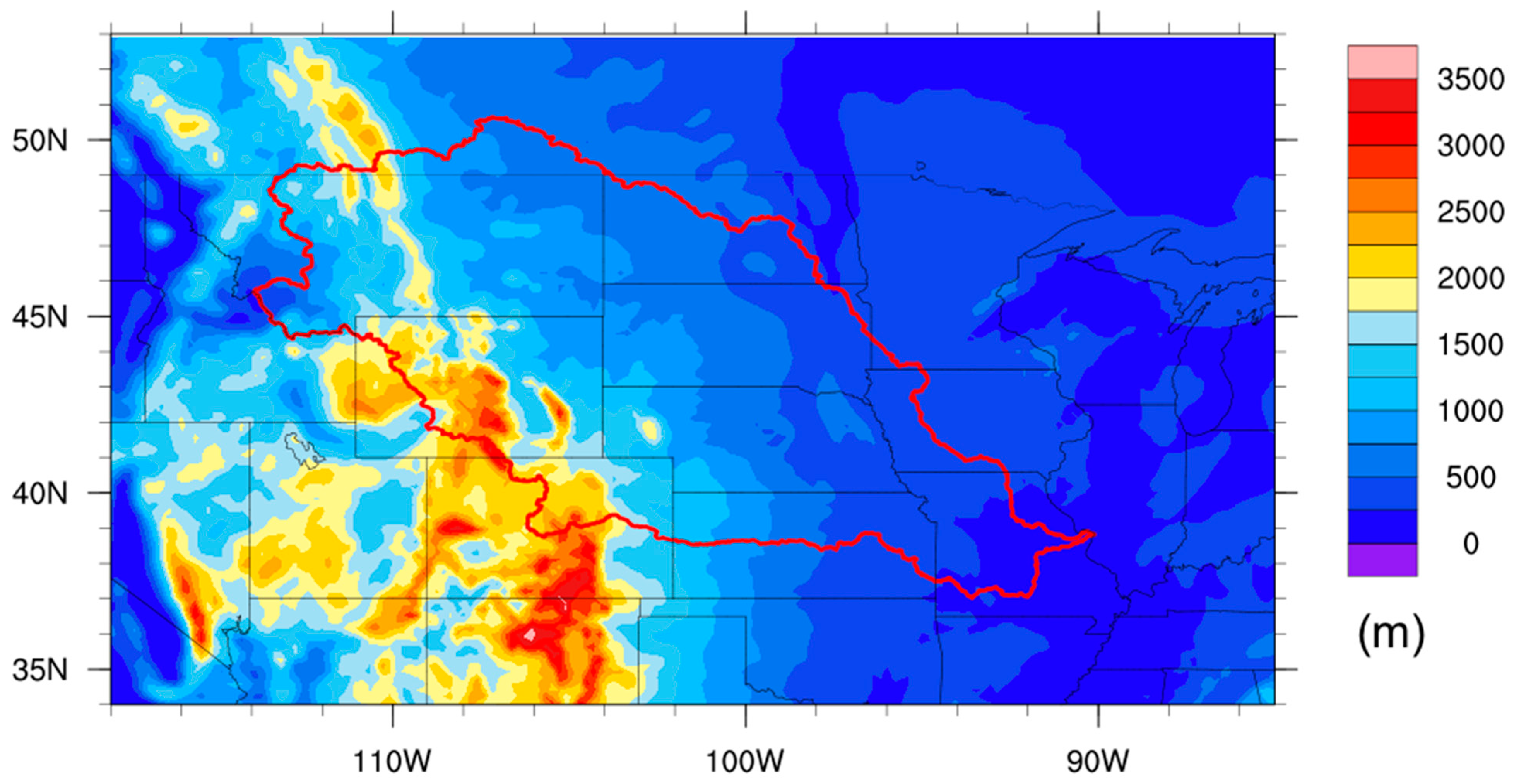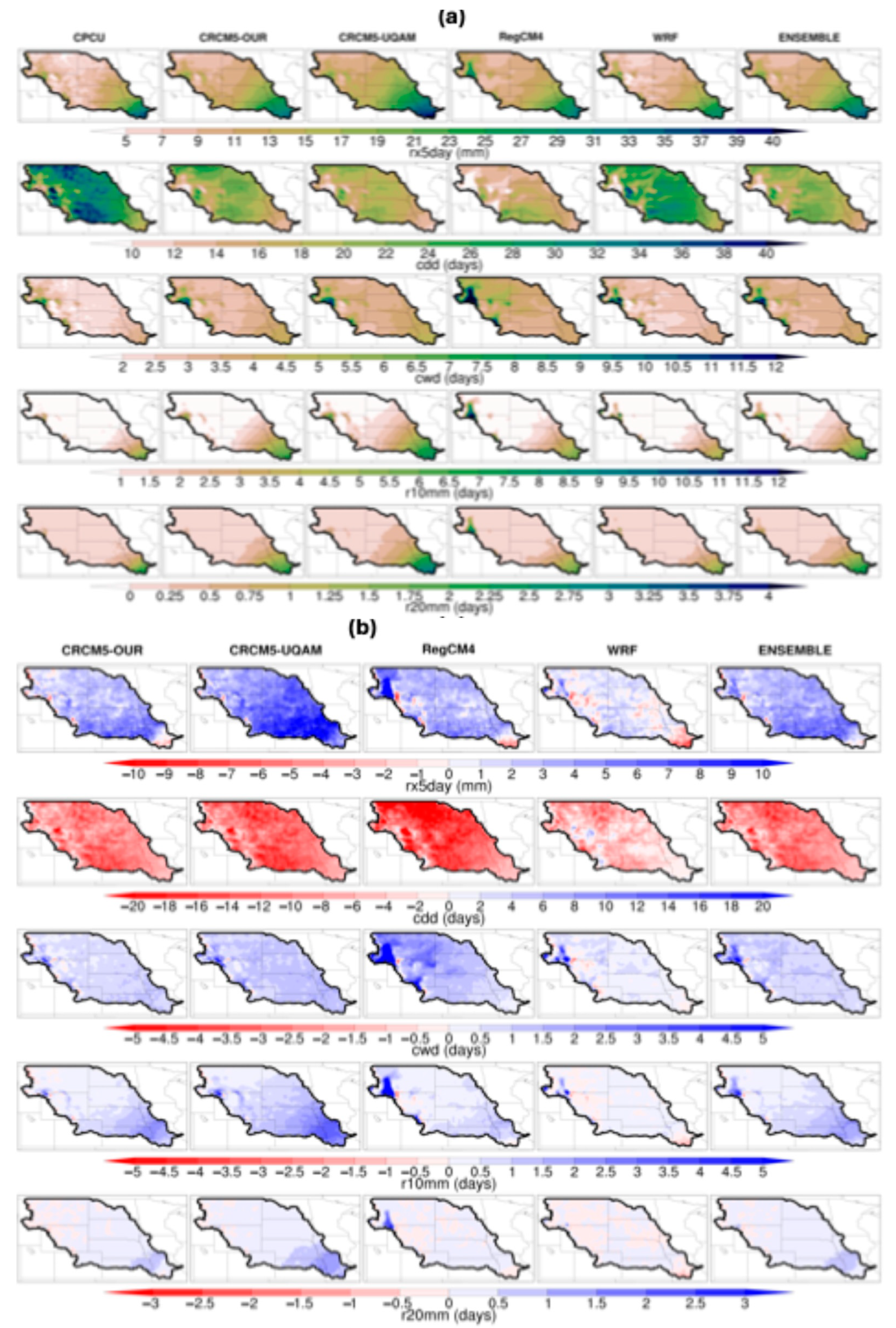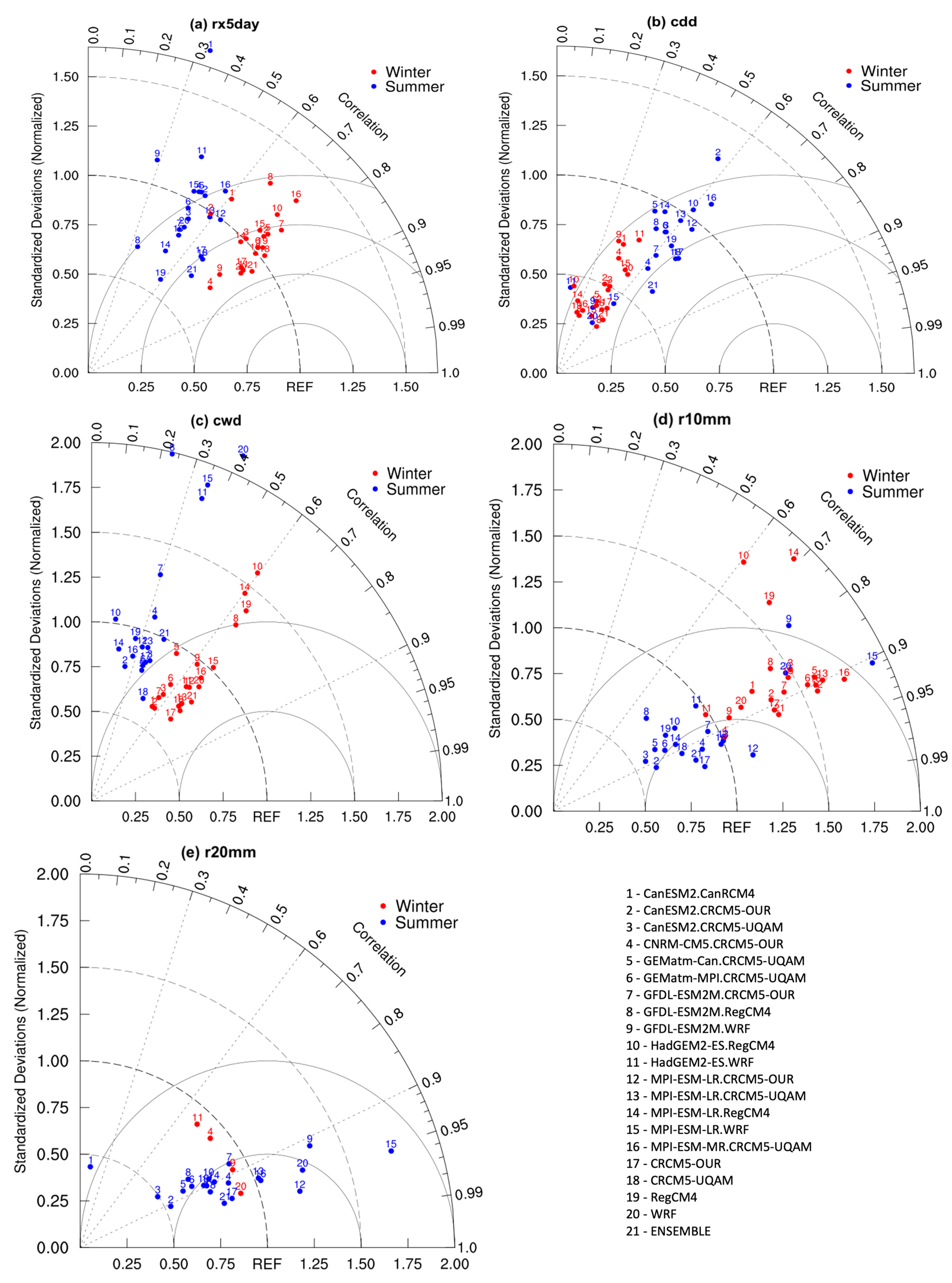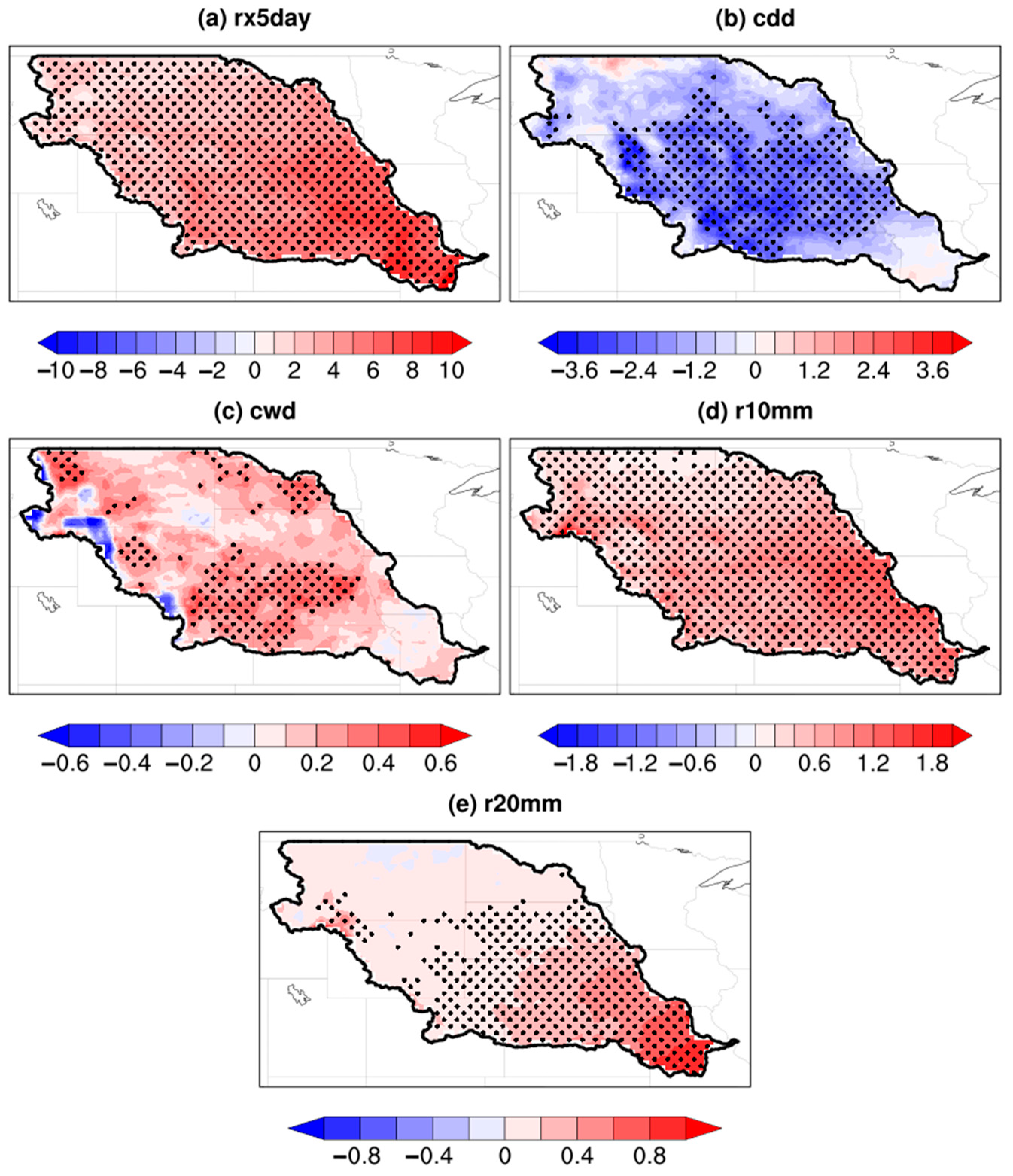Evaluating the Historical Performance and Future Change in Extreme Precipitation Indices over the Missouri River Basin Based on NA-CORDEX Multimodel Ensemble
Abstract
1. Introduction
2. Data and Methodology
2.1. Study Area
2.2. Data
2.3. Extreme Precipitation Indices
2.4. Method of Evaluation and Analysis
2.5. Extreme Precipitation Analysis
3. Results and Discussion
3.1. Mean Climatology of Precipitation
3.2. Spatial Distribution of Historical Extreme Precipitation Indices
3.3. Statistical Evaluation of the Model’s Extreme Precipitation Indices
3.4. Future Change in Extreme Precipitation Indices
4. Discussions
5. Conclusions
Supplementary Materials
Author Contributions
Funding
Institutional Review Board Statement
Informed Consent Statement
Data Availability Statement
Acknowledgments
Conflicts of Interest
References
- Flanagan, P.X.; Mahmood, R.; Umphlett, N.A.; Haacker, E.; Ray, C.; Sorensen, W.; Shulski, M.; Stiles, C.J.; Pearson, D.; Fajman, P. A Hydrometeorological Assessment of the Historic 2019 Flood of Nebraska, Iowa, and South Dakota. Bull. Am. Meteorol. Soc. 2020, 101, E817–E829. [Google Scholar] [CrossRef]
- USDA, Farmers Prevented from Planting Crops on More than 19 Million Acres. Farm Service Agency. 2019. Available online: https://www.fsa.usda.gov/news-room/news-releases/2019/report-farmers-prevented-from-planting-crops-on-more-than-19-million-acres (accessed on 30 June 2020).
- Yang, Z.; Qian, Y.; Liu, Y.; Berg, L.K.; Gustafson, W.I.; Feng, Z.; Sakaguchi, K.; Fast, J.D.; Tai, S.-L.; Yang, B.; et al. Understanding irrigation impacts on low-level jets over the Great Plains. Clim. Dyn. 2020, 55, 925–943. [Google Scholar] [CrossRef]
- Song, F.; Leung, L.R.; Feng, Z.; Chen, X.; Yang, Q. Observed and projected changes of large-scale environments conducive to spring MCS initiation over the US Great Plains. Geophys. Res. Lett. 2022, 49, e2022GL098799. [Google Scholar] [CrossRef]
- Millin, O.T.; Furtado, J.C. The role of wave breaking in the development and subseasonal forecasts of the February 2021 Great Plains cold air outbreak. Geophys. Res. Lett. 2022, 49, e2022GL100835. [Google Scholar] [CrossRef]
- Rosenzweig, C.; Tubiello, F.N.; Goldberg, R.; Mills, E.; Bloomfield, J. Increased crop damage in the US from excess precipitation under climate change. Glob. Environ. Change 2002, 12, 197–202. [Google Scholar] [CrossRef]
- Maurer, E.P.; Lettenmaier, D.P. Potential effects of long-lead hydrologic predictability on Missouri River main-stem reservoirs. J. Climate 2004, 17, 174–186. [Google Scholar] [CrossRef]
- Ettema, R.; Zabilansky, L. Ice influences on channel stability: Insights from Missouri’s fort peck reach. J. Hydraul. Eng. 2004, 130, 279–292. [Google Scholar] [CrossRef]
- Qiao, L.; Pan, Z.; Herrmann, R.B.; Hong, Y. Hydrological variability and uncertainty of lower Missouri River basin under changing climate. J. Amer. Water Resour. Assoc. 2014, 50, 246–260. [Google Scholar] [CrossRef]
- Najibi, N.; Devineni, N.; Lu, M. Hydroclimate drivers and atmospheric teleconnections of long duration floods: An application to large reservoirs in the Missouri River basin. Adv. Water Resour. 2017, 100, 153–167. [Google Scholar] [CrossRef]
- Wise, E.K.; Woodhouse, C.A.; McCabe, G.J.; Pederson, G.T.; St-Jacques, J.-M. Hydroclimatology of the Missouri River basin. J. Hydrol. 2018, 19, 161–182. [Google Scholar] [CrossRef]
- Lopez-Cantu, T.; Prein, A.F.; Samaras, C. Uncertainties in future U.S. extreme precipitation from downscaled climate projections. Geophys. Res. Lett. 2020, 47, e2019GL086797. [Google Scholar] [CrossRef]
- Flanagan, P.; Mahmood, R. Spatiotemporal Analysis of Extreme Precipitation in the Missouri River Basin from 1950 to 2019. J. Appl. Meteorol. Climatol. 2021, 60, 811–827. [Google Scholar] [CrossRef]
- Di Luca, A.; De Elía, R.; Laprise, R. Potential for added value in precipitation simulated by high-resolution nested Regional Climate Models and observations. Clim. Dyn. 2011, 38, 1229–1247. [Google Scholar] [CrossRef]
- Ashfaq, M.; Rastogi, D.; Mei, R.; Kao, S.C.; Gangrade, S.; Naz, B.S.; Touma, D. High-resolution ensemble projections of near-term regional climate over the continental United States. J. Geophys. Res. Atmos. 2016, 121, 9943–9963. [Google Scholar] [CrossRef]
- Lucas-Picher, P.; Laprise, R.; Winger, K. Evidence of added value in North American regional climate model hindcast simulations using ever-increasing horizontal resolutions. Clim. Dyn. 2016, 48, 2611–2633. [Google Scholar] [CrossRef]
- Leung, L.R.; Mearns, L.O.; Giorgi, F.; Wilby, R.L. Regional climate research: Needs and opportunities. Bull. Amer. Meteor. Soc. 2003, 84, 89–95. [Google Scholar] [CrossRef]
- Bukovsky, M.S.; Mearns, L.O. Regional climate change projections from NA-CORDEX and their relation to climate sensitivity. Clim. Change 2020, 162, 645–665. [Google Scholar] [CrossRef]
- Pierce, D.W.; Cayan, D.R.; Feldman, D.R.; Risser, M.D. Future Increases in North American Extreme Precipitation in CMIP6 Downscaled with LOCA. J. Hydrometeorol. 2003, 24, 951–975. [Google Scholar] [CrossRef]
- Thrasher, B.; Wang, W.; Michaelis, A.; Melton, F.; Lee, T.; Nemani, R. NASA Global Daily Downscaled Projections, CMIP6. Sci. Data 2022, 9, 262. [Google Scholar] [CrossRef]
- Karmalkar, A.V. Interpreting Results from the NARCCAP and NA-CORDEX Ensembles in the Context of Uncertainty in Regional Climate Change Projections. Bull. Am. Meteorol. Soc. 2018, 99, 2093–2106. [Google Scholar] [CrossRef]
- Fisel, B.J.; Erickson, N.E.; Young, C.R.; Ellingworth, A.L.; Gutowski, W.J., Jr. Evaluating Contemporary and Future-Scenario Substantial-Precipitation Events in the Missouri River Basin Using Object-Oriented Analysis. Climate 2023, 11, 112. [Google Scholar] [CrossRef]
- Mehta, V.M.; Knutson, C.L.; Rosenberg, N.J.; Olsen, J.R.; Wall, N.A.; Bernadt, T.K.; Hayes, M.J. Decadal Climate Information Needs of Stakeholders for Decision Support in Water and Agriculture Production Sectors: A Case Study in the Missouri River Basin. Weather. Clim. Soc. 2013, 5, 27–42. [Google Scholar] [CrossRef]
- Mearns, L.O.; McGinnis, S.; Korytina, D.; Arritt, R.; Biner, S.; Bukovsky, M.; Chang, H.-I.; Christensen, O.; Herzmann, D.; Jiao, Y.; et al. The NA-CORDEX Dataset, version 1.0; NCAR Climate Data Gateway: Boulder, CO, USA, 2017. [Google Scholar] [CrossRef]
- Meyer, J.D.D.; Wang, S.-Y.S.; Gillies, R.R.; Yoon, J.-H. Evaluating NA-CORDEX historical performance and future change of western U.S. precipitation patterns and modes of variability. Int. J. Climatol. 2021, 41, 4509–4532. [Google Scholar] [CrossRef]
- Chen, M.; Shi, W.; Xie, P.; Silva, V.B.; Kousky, V.E.; Wayne Higgins, R.; Janowiak, J.E. Assessing objective techniques for gauge-based analyses of global daily precipitation. J. Geophys. Res. 2008, 113, D04110. [Google Scholar] [CrossRef]
- Mallakpour, I.; Sadeghi, M.; Mosaffa, H.; Asanjan, A.A.; Sadegh, M.; Nguyen, P.; Sorooshian, S.; AghaKouchak, A. Discrepancies in changes in precipitation characteristics over the contiguous United States based on six daily gridded precipitation datasets. Weather. Clim. Extremes 2022, 36, 100433. [Google Scholar] [CrossRef]
- Rahmani, V.; Harrington, J. Assessment of climate change for extreme precipitation indices: A case study from the central United States. Int. J. Climatol. 2018, 39, 1013–1025. [Google Scholar] [CrossRef]
- Funk, C.; Peterson, P.; Landsfeld, M.; Pedreros, D.; Verdin, J.; Shukla, S.; Husak, G.; Rowland, J.; Harrison, L.; Hoell, A.; et al. The climate hazards infrared precipitation with stations—A new environmental record for monitoring extremes. Sci. Data 2015, 2, 150066. [Google Scholar] [CrossRef]
- Sillmann, J.; Kharin, V.V.; Zhang, X.; Zwiers, F.W.; Bronaugh, D. Climate extremes indices in the CMIP5 multimodel ensemble: Part 1. Model evaluation in the present climate. J. Geophys. Res. 2013, 118, 1716–1733. [Google Scholar] [CrossRef]
- Singh, D.; Tsiang, M.; Rajaratnam, B.; Diffenbaugh, N.S. Precipitation extremes over the continental United States in a transient, high-resolution, ensemble climate model experiment. J. Geophys. Res. Atmos. 2013, 118, 7063–7086. [Google Scholar] [CrossRef]
- Ngai, S.T.; Juneng, L.; Tangang, F.; Chung, J.X.; Supari, S.; Salimun, E.; Cruz, F.; Ngo-Duc, T.; Phan-Van, T.; Santisirisomboon, J.; et al. Projected mean and extreme precipitation based on bias-corrected simulation outputs of CORDEX Southeast Asia. Weather Clim. Extremes 2022, 37, 100484. [Google Scholar] [CrossRef]
- Akinsanola, A.A.; Ongoma, V.; Kooperman, G.J. Evaluation of CMIP6 models in simulating the statistics of extreme precipitation over Eastern Africa. Atmos. Res. 2021, 254, 105509. [Google Scholar] [CrossRef]
- Gbode, I.E.; Babalola, T.E.; Diro, G.T.; Intsiful, J.D. Assessment of ERA5 and ERA-Interim in reproducing mean and extreme climates over West Africa. Adv. Atmos. Sci. 2023, 40, 570–586. [Google Scholar] [CrossRef]
- Taylor, K.E. Summarizing multiple aspects of model performance in a single diagram. J. Geophys. Res. Atmos. 2021, 106, 7183–7192. [Google Scholar] [CrossRef]
- Houghton, J.; Ding, Y.; Griggs, D.J.; Noguer, M.; van der Linden, P.J.; Xiaosu, D. Climate Change 2001: The Scientific Basis; Contribution of Working Group I to the 3rd Assessment Report of the Intergovernmental Panel on Climate Change; Cambridge University Press: Cambridge, UK, 2001. [Google Scholar]
- Nazarian, R.H.; Vizzard, J.V.; Agostino, C.P.; Lutsko, N.J. Projected Changes in Future Extreme Precipitation over the Northeast United States in the Na-Cordex Ensemble. J. Appl. Meteorol. Clim. 2022, 61, 1649–1668. [Google Scholar] [CrossRef]
- Bukovsky, M.S.; Gochis, D.J.; Mearns, L.O. Towards assessing NARCCAP regional climate model credibility for the North American monsoon: Current climate simulations. J. Clim. 2013, 26, 8802–8826. [Google Scholar] [CrossRef]
- Meyer, J.D.D.; Jin, J. Bias correction of the CCSM4 for improved regional climate modeling of the North American monsoon. Clim. Dyn. 2016, 46, 2961–2976. [Google Scholar] [CrossRef]
- Grady, K.A.; Chen, L.; Ford, T.W. Projected Changes to Spring and Summer Precipitation in the Midwestern United States. Front. Water 2021, 3, 780333. [Google Scholar] [CrossRef]
- Dollan, I.J.; Maggioni, V.; Johnston, J.; Coelho, G.d.A.; Kinter, J.L., III. Seasonal variability of future extreme precipitation and associated trends across the Contiguous U.S. Front. Clim. 2022, 4, 954892. [Google Scholar] [CrossRef]
- Giorgi, F.; Raffaele, F.; Coppola, E. The response of precipitation characteristics to global warming from climate projections. Earth Syst. Dyn. 2019, 10, 73–89. [Google Scholar] [CrossRef]
- Zhang, H.; Delworth, T.L. Robustness of anthropogenically forced decadal precipitation changes projected for the twenty-first century. Nat. Commun. 2018, 9, 1150. [Google Scholar] [CrossRef]
- Deser, C.; Phillips, A.; Bourdette, V.; Teng, H. Uncertainty in climate change projections: The role of internal variability. Clim. Dyn. 2012, 38, 527–546. [Google Scholar] [CrossRef]
- Pendergrass, A.G.; Gerber, E.P. The rain is askew: Two idealized models relating vertical velocity and precipitation distributions in a warming world. J. Climate 2016, 29, 6445–6462. [Google Scholar] [CrossRef]
- Wrzesien, M.L.; Pavelsky, T.M. Projected Changes to Extreme Runoff and Precipitation Events from a Downscaled Simulation Over the Western United States. Front. Earth Sci. 2020, 7, 355. [Google Scholar] [CrossRef]
- Flanagan, P.X.; Basara, J.B.; Xiao, X. Long-term analysis of the asynchronicity between temperature and precipitation maxima in the United States Great Plains. Int. J. Climatol. 2017, 37, 3919–3933. [Google Scholar] [CrossRef]
- Pokorný, J.; Rejšková, A. Water Cycle Management. In Elsevier eBooks; Elsevier: Amsterdam, The Netherlands, 2008; pp. 3729–3737. [Google Scholar] [CrossRef]
- Ford, C.M.; Kendall, A.D.; Hyndman, D.W. Effects of shifting snowmelt regimes on the hydrology of non-alpine temperate landscapes. J. Hydrol. 2020, 590, 125517. [Google Scholar] [CrossRef]
- NWS (National Weather Service) Report on Mississippi River Flood History 1543–Present. 2019. Available online: https://www.weather.gov/lix/ms_flood_history (accessed on 3 August 2024).
- Byrne, M.P.; O’Gorman, P.A. The response of precipitation minus evapotranspiration to climate warming: Why the “Wet-Get-Wetter, Dry-Get-Drier” scaling does not hold over land. J. Clim. 2015, 28, 8078–8092. [Google Scholar] [CrossRef]
- EPA (United States Environmental Protection Agency). What Climate Change Means for Missouri. 2016. Available online: https://19january2017snapshot.epa.gov/sites/production/files/2016-09/documents/climate-change-mo.pdf (accessed on 28 July 2024).
- Wuebbles, D.; Angel, J.; Petersen, K.; Lemke, A.M. An Assessment of the Impacts of Climate Change in Illinois; The Nature Conservancy: Chicago, IL, USA, 2021. [Google Scholar] [CrossRef]
- Eyring, V.; Bony, S.; Meehl, G.A.; Senior, C.A.; Stevens, B.; Stouffer, R.J.; Taylor, K.E. Overview of the couple model intercomparison project phase 6 (CMIP6) experimental design and organization. Geosci. Model Dev. 2016, 9, 1937–1958. [Google Scholar] [CrossRef]







| GCMs | RCMs | |
|---|---|---|
| 1 | HadGEM2-ES | WRF |
| 2 | GFDL-ESM2M | |
| 3 | MPI-ESM-LR | |
| 4 | MPI-ESM-MR | CRCM5-UQAM |
| 5 | CanESM2 | |
| 6 | GEMatm-MPI | |
| 7 | GEMatm-Can | |
| 8 | MPI-ESM-LR | |
| 9 | CNRM-CM5 | CRCM5-OUR |
| 10 | CanESM2 | |
| 11 | GFDL-ESM2M | |
| 12 | MPI-ESM-LR | |
| 13 | CanESM2 | CanRCM4 |
| 14 | MPI-ESM-LR | RegCM4 |
| 15 | HadGEM2-ES | |
| 16 | GFDL-ESM2M |
| Short Name of Extreme Indices | Name of Extreme Indices | Definition of Indices | Units |
|---|---|---|---|
| rx5day | Max. 5-day precipitation | Maximum 5-day precipitation total, i.e., maximum amount of rain that falls in five consecutive days | mm |
| cdd | Consecutive dry days | Counting the maximum number of consecutive dry days when precipitation is less than 1 mm, i.e., the longest dry spell. | days |
| cwd | Consecutive wet days | The highest number of consecutive days when precipitation is greater than or equal to 1 mm, i.e., the longest wet spell. | days |
| r10mm | Heavy precipitation days | Counting the total number of days with precipitation ≥ 10 mm | days |
| r20mm | Very heavy precipitation days | Counting the total number of days with precipitation ≥ 20 mm | days |
| Summer | Winter | |
|---|---|---|
| rx5day |
MPI-ESM-LR.CRCM5-OUR, MPI-ESM-LR.CRCM5-UQAM, MPI-ESM-LR.RegCM4, GFDL-ESM2M.CRCM5-OUR, HadGEM2-ES.RegCM4 | HadGEM2-ES.WRF, CNRM-CM5.CRCM5-OUR, MPI-ESM-LR.CRCM5-UQAM, GFDL-ESM2M.WRF, GEMatm-MPI.CRCM5-UQAM |
| cdd |
CNRM-CM5.CRCM5-OUR, GFDL-ESM2M.CRCM5-OUR, MPI-ESM-LR.CRCM5-OUR, MPI-ESM-LR.WRF, MPI-ESM-LR.CRCM5-UQAM. |
GEMatm-MPI.CRCM5-UQAM, MPI-ESM-LR.CRCM5-OUR, MPI-ESM-LR.WRF, CanESM2.CRCM5-UQAM, GFDL-ESM2M.CRCM5-OUR. |
| cwd |
GEMatm-Can.CRCM5-UQAM, GFDL-ESM2M.RegCM4, GEMatm-MPI.CRCM5-UQAM, MPI-ESM-LR.CRCM5-UQAM, MPI-ESM-LR.CRCM5-OUR |
CNRM-CM5.CRCM5-OUR, MPI-ESM-LR.CRCM5-UQAM, MPI-ESM-LR.CRCM5-OUR, MPI-ESM-MR.CRCM5-UQAM, HadGEM2-ES.WRF. |
| r10mm |
MPI-ESM-LR.CRCM5-OUR, CNRM-CM5.CRCM5-OUR, MPI-ESM-MR.CRCM5-UQAM, MPI-ESM-LR.CRCM5-UQAM, GFDL-ESM2M.CRCM5-OUR |
CNRM-CM5.CRCM5-OUR, GFDL-ESM2M.WRF, HadGEM2-ES.WRF, CanESM2.CRCM5-OUR, CanESM2.CanRCM4 |
| r20mm |
MPI-ESM-LR.CRCM5-OUR, MPI-ESM-LR.CRCM5-UQAM, MPI-ESM-MR.CRCM5-UQAM, MPI-ESM-LR.CRCM5-UQAM, GFDL-ESM2M.CRCM5-OUR |
GFDL-ESM2M.WRF, CNRM-CM5.CRCM5-OUR, HadGEM2-ES.WRF, GFDL-ESM2M.RegCM4, GFDL-ESM2M.CRCM5-OUR |
Disclaimer/Publisher’s Note: The statements, opinions and data contained in all publications are solely those of the individual author(s) and contributor(s) and not of MDPI and/or the editor(s). MDPI and/or the editor(s) disclaim responsibility for any injury to people or property resulting from any ideas, methods, instructions or products referred to in the content. |
© 2025 by the authors. Licensee MDPI, Basel, Switzerland. This article is an open access article distributed under the terms and conditions of the Creative Commons Attribution (CC BY) license (https://creativecommons.org/licenses/by/4.0/).
Share and Cite
Achugbu, I.C.; Chen, L.; Hu, Q.; Muñoz-Arriola, F. Evaluating the Historical Performance and Future Change in Extreme Precipitation Indices over the Missouri River Basin Based on NA-CORDEX Multimodel Ensemble. Atmosphere 2025, 16, 579. https://doi.org/10.3390/atmos16050579
Achugbu IC, Chen L, Hu Q, Muñoz-Arriola F. Evaluating the Historical Performance and Future Change in Extreme Precipitation Indices over the Missouri River Basin Based on NA-CORDEX Multimodel Ensemble. Atmosphere. 2025; 16(5):579. https://doi.org/10.3390/atmos16050579
Chicago/Turabian StyleAchugbu, Ifeanyi Chukwudi, Liang Chen, Qi Hu, and Francisco Muñoz-Arriola. 2025. "Evaluating the Historical Performance and Future Change in Extreme Precipitation Indices over the Missouri River Basin Based on NA-CORDEX Multimodel Ensemble" Atmosphere 16, no. 5: 579. https://doi.org/10.3390/atmos16050579
APA StyleAchugbu, I. C., Chen, L., Hu, Q., & Muñoz-Arriola, F. (2025). Evaluating the Historical Performance and Future Change in Extreme Precipitation Indices over the Missouri River Basin Based on NA-CORDEX Multimodel Ensemble. Atmosphere, 16(5), 579. https://doi.org/10.3390/atmos16050579






